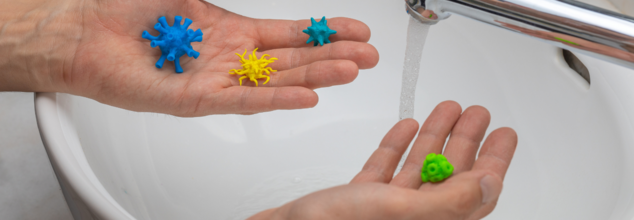- Health Conditions A-Z
- Health & Wellness
- Nutrition
- Fitness
- Health News
- Ayurveda
- Videos
- Medicine A-Z
- Parenting
- Web Stories
Things In Your Home That You May Not Be Cleaning Enough

(Credit-Canva)
When it comes to keeping your home clean, people do not leave any stone unturned. Our parents would often nag us to clean our rooms and keep the house clean. While it would annoy us to no end, growing up we understood why they encouraged us to keep the place we live in clean. It's not just about making it look good, but also about protecting it from harmful bacteria and germs.
While your home may be your personal space, it can quickly become a breeding ground for germs. You are also more likely to fall sick due to an unhygienic space as you spend a lot of time at home, including resting and sleeping.
However, while you may clean your floors, your closet and the washroom frequently, there are many unsuspecting items that are not cleaned as often, sometimes not at all. These items are mostly used daily, and do not need to be cleaned daily. As insignificant these may seem, periodically cleaning them is necessary to stop them from becoming breeding grounds for health issues.
Unlikely Things That Get Neglected Being Cleaned
Sponges and Dish Cloths
Before tackling dishes or counters, remember your sponge and cloth can be very unclean. They collect food scraps and messes, creating a damp home for harmful bacteria that soap alone won't eliminate. A study published in the American Society of Microbiology revealed that 49% of kitchen towels have bad bacteria. Boiling your kitchen towels may be a good practice to keep hygiene otherwise you replace them periodically.
Carpets and Rugs
Consider everything tracked onto your floors – dirt, mud, and even tiny waste particles. According to research done by Philip Tierno Jr., Ph.D., a microbiologist and immunologist, carpets are 4000 times dirtier than your toilet seats. Shed skin feeds these germs, and rugs trap allergens and pet dander. Regular vacuuming isn't sufficient; the aim for professional deep cleaning annually to remove hidden contaminants.
Cutting Boards
Your cutting board, used for various foods like veggies and raw meat, can easily spread harmful bacteria if not properly cleaned. According to the North Carolina State University, plastic boards can develop germ-trapping grooves, while wood is harder to sanitize. Using separate boards for different food types and thorough washing after each use are crucial for preventing foodborne illness.
Toothbrush Holders
You diligently brush your teeth, but the storage of your toothbrush matters. Damp toothbrush holders, especially in steamy bathrooms, become ideal breeding grounds for various germs. These accumulate, and touching the holder can transfer thousands of microorganisms. Weekly washing with soap or dishwasher cleaning can help maintain a cleaner storage environment.
Coffee Makers
While you likely wash your mug daily, neglecting your coffee maker can lead to more than just a caffeine boost. Single-serve machines have water tanks where bacteria, mold, and yeast can thrive. Experts advise emptying and drying the tank after each use and descaling the machine regularly to prevent unwanted microbial growth.
Tech Gadgets
Think of the many hands touching your remote, the crumbs in your keyboard, and the constant handling of your phone. These shared devices can be surprisingly unclean, with keyboards harboring significant bacteria. Regular wiping with disinfectant and frequent handwashing are essential to minimize germ transfer from these commonly used items.
Pillows
Prepare yourself; your pillows can be a haven for dust mites, dead skin cells, and bodily fluids over time. Experts liken them to damp sponges that absorb various substances, creating a thriving environment for these unwanted guests. Regular washing every six months, annual replacement, and dust mite covers are recommended for cleaner sleep.
World Lung Cancer Day 2025: Is Pollution The New Cigarette For Your Lungs? 5 Habits To Save Your Breath

Credits: Health and me
When you stop for a moment, take a deep breath. How clean do you think is the air you just inhaled? If you live in a city or anywhere near heavy traffic, construction zones, or industrial areas chances are that breath carried more than just oxygen. Increasingly, health experts are raising a red flag: air pollution is becoming just as dangerous for your lungs as cigarette smoke. Unlike a lit cigarette, you can’t see it or smell it as easily, but the damage? It’s happening all the same—quietly, gradually, and across the globe.
On World Lung Cancer Day, it’s time to stop treating pollution as a background inconvenience and start seeing it for what it is: a major, modifiable threat to lung health.
We’ve long understood smoking as the leading cause of lung cancer, but the health narrative is shifting. Air pollution is catching up—and fast. According to the World Health Organization, over 7 million people die each year from air pollution, with billions more living with compromised respiratory health. Dr. Tedros Adhanom Ghebreyesus, Director-General of WHO, didn’t mince words back in 2018 when he said, “Air pollution is the new tobacco.”
The culprits are tiny, invisible particles like PM2.5 and PM10, nitrogen dioxide from vehicles, and toxins from burning biomass or fossil fuels. These pollutants don’t just irritate the lungs—they penetrate deep into lung tissue, triggering inflammation, reducing immune clearance, and increasing the risk of chronic respiratory illnesses and cancer. As the air gets dirtier, lung cancer in non-smokers—especially women and young adults—is on the rise.
Is Air Pollution Is the New Smoking?
We are already witnessing the consequences of environmental neglect warns Dr. Sachin Trivedi, Director of Medical Oncology at HCG ICS Khubchandani Cancer Centre, further adding, "Cigarette smoking has been known to be the major cause of lung cancer over the past decades. But there is a more recent and equally threatening danger that is on the rise: air pollution."
Dr. Trivedi highlights that a significant number of lung cancer diagnoses are now occurring in non-smokers, suggesting a stronger role for environmental pollutants. From vehicle emissions and industrial fumes to household fuel burning, the sources of this silent threat are everywhere. These pollutants infiltrate deep into the lungs, sparking chronic inflammation, oxidative stress, DNA damage, and even malignant mutations.
Why Lung Damage Due To Pollution Doesn’t Show Symptoms?
Even more concerning, these changes often don’t produce symptoms until the disease is advanced. Which is why early detection, lifestyle awareness, and pollution avoidance are critical. Dr. Trivedi urges individuals to recognize and act on subtle warning signs like chronic cough, shortness of breath, or unexplained weight loss, especially among non-smokers who may not suspect lung cancer.
5 Lung-Saving Habits You Can Practice Daily
Despite the scale of the problem, Dr. Trivedi emphasizes that it’s possible to shield your lungs through smart, consistent habits:
1. Wear a Protective Mask Outdoors
Especially in high-traffic or industrial areas, an N95 mask can block harmful particles like PM2.5. It’s a frontline defense your lungs will thank you for.
2. Maintain Clean Indoor Air
Ventilation is key. Use exhaust fans in kitchens, avoid indoor smoking, and install HEPA-filter air purifiers in high-pollution zones. Urban homes need this extra layer of air hygiene.
3. Limit Outdoor Time on High AQI Days
Track air quality through reliable apps. Skip rush hour outings and outdoor workouts when air quality is poor. Exposure control is protection.
4. Eat an Antioxidant-Rich, Lung-Friendly Diet
What you eat matters. A diet high in vitamins A, C, and E from foods like berries, citrus fruits, broccoli, and nuts can counter oxidative lung damage. Turmeric and green tea also offer anti-inflammatory benefits.
5. Don’t Dismiss Early Symptoms
A persistent cough or breathlessness isn’t always a passing cold. Get medical attention early—especially if you're a non-smoker experiencing unusual respiratory symptoms.
Dr. Devendra Parikh, Consultant in Surgical Oncology at HCG Aastha Cancer Centre, adds in a perspective, "Chronic polluted air harms our lungs just as smoking does: it silently, over time, injures delicate tissue and raises cancer risk. He stresses that fine particles from cooking smoke, traffic fumes, or even poorly ventilated homes carry microscopic toxins that inflame lung tissue and trigger genetic changes." He further shares more ways in which you can protect yourself
- Checking your local AQI each morning helps you make smarter decisions. When air quality dips, stay indoors and keep windows shut.
- These devices capture up to 99.97% of fine particles, drastically improving indoor air. Even running a unit for a few hours can ease respiratory strain.
- A proper N95 or KN95 mask creates a secure barrier against inhaling toxic particles. It’s essential during commutes or outdoor errands on high-smog days.
- Simple breathwork techniques or pranayama for five minutes daily can help clear the lungs and improve capacity.
- For those over 50 or with occupational exposure, low-dose CT scans can detect early signs of lung cancer—even before symptoms begin. Early action saves lives.
You can’t filter the world. But you can control your exposure, build resilient habits, and stay alert to what your lungs are telling you. The new reality is this: pollution is the new cigarette, and we can no longer afford to breathe without awareness. On World Lung Cancer Day and beyond—your breath is worth protecting. In cities where clean air isn’t guaranteed, your daily choices are your lungs’ best defense.
Pollution may feel as unavoidable as city noise, but it doesn’t have to be as destructive. By weaving these habits into your daily life, you give your lungs the best chance to clear toxins, reduce inflammation, and ward off the long-term threat of lung cancer.
PCOS Isn’t Just Hormonal, It Might Be Fueling This Dangerous Heart Condition

Credits: Canva
Polycystic Ovary Syndrome (PCOS) is often dismissed as a reproductive or cosmetic issue—a condition marked by irregular periods, acne, and weight fluctuations. But the hormonal and metabolic underpinnings of PCOS go much deeper. New findings presented at ENDO 2025, the annual meeting of the Endocrine Society, now highlight a troubling link: PCOS may significantly increase the risk of vascular events in women with thrombotic disease, and these events are occurring at increasingly younger ages.
The research, presented by a team from Riverside University Health System Medical Center and supported by national health data, suggests that the combination of PCOS and thrombotic disease creates a more dangerous cardiovascular profile, one that might be going under-recognized in clinical settings.
The analysis drew on records from the National Inpatient Sample (NIS), evaluating over 205,000 women hospitalized between 2016 and 2022 for thrombotic, atherosclerotic, or cerebrovascular diseases. The goal was to see how outcomes differed based on the presence or absence of comorbid PCOS. The findings were both significant and sobering:
Women with both PCOS and thrombotic disease had higher stroke rates (14.81%) compared to those without PCOS (11.91%).
A greater percentage of women with PCOS were under the age of 50 at the time of their vascular event compared to those without PCOS across all categories—thrombotic, atherosclerotic, and cerebrovascular.
Also Read: Your Home May Look Clean, But These 8 Spots Are Dirtier Than You Think
Despite the younger age of presentation, in-hospital mortality rates were similar between women with and without PCOS, suggesting the seriousness of these events in younger populations is not being offset by age-related resilience.
Dr. Alexander Lim, DO, who presented the findings, noted, “We found that cardiovascular events in women with PCOS were more likely to occur at an earlier age. The risk tends to decrease with age, possibly due to underdiagnosis of PCOS in older women or survivorship bias.”
Why Metabolic Difficulties Due To PCOS Lead Vascular Complications?
To understand why PCOS might elevate vascular risk, it's crucial to look at its underlying pathology. PCOS is not just a hormonal disorder—it’s also deeply metabolic.
Women with PCOS frequently exhibit insulin resistance, even if they are not overweight. This insulin resistance is a precursor to type 2 diabetes, hypertension, nonalcoholic fatty liver disease, and dyslipidemia—all conditions that significantly increase the risk of both arterial and venous thrombotic events.
Despite this, clinical management of PCOS often remains centered on cosmetic symptoms (like acne and hirsutism) or fertility concerns, rather than addressing the long-term metabolic and cardiovascular consequences. This treatment gap may explain why vascular events in women with PCOS catch both patients and providers off guard.
Why Current Testing May Be Failing Women?
Another striking aspect of the new research is that women with PCOS who experienced recurrent thrombotic events (strokes, heart attacks, pulmonary embolisms) often showed normal results in standard coagulation tests. This was identified in a diagnostic review by a coagulation management team and later verified through a national data set analysis using TriNetX, a large health research network.
Between 2013 and 2018, researchers used the TriNetX platform to analyze PCOS patients aged 15–75, excluding those with known thrombotic disorders, smoking history, or HIV. They found that thrombotic events occurred at significantly higher rates in women with PCOS compared to matched controls, even though clinical tests failed to detect abnormalities in coagulation.
What this suggests is that standard coagulation assays may not be sensitive enough to detect the unique thrombotic risk profile in PCOS, raising concerns about diagnostic error or delayed interventions.
This is the first large-scale study to systematically evaluate the rate and clinical presentation of thrombotic events in women with PCOS using national data and validated diagnostic algorithms like SPADE (Symptom-Disease Pair Analysis of Diagnostic Error).
By comparing outcomes 90 days prior to major thrombotic events, the researchers identified consistent symptom patterns—including subtle indicators—that could serve as early warning signs for intervention. However, the precise biological mechanisms behind thrombosis in PCOS remain poorly understood.
The message is clear: PCOS isn’t just a reproductive disorder—it’s a systemic, vascular-risk condition that can dramatically impact a woman’s health long before menopause. Clinicians need to think beyond fertility and skin health and recognize that young women with PCOS may be walking around with unrecognized cardiovascular vulnerabilities.
For women living with PCOS, this means that a heart-healthy lifestyle—including regular cardiovascular screening, metabolic management, and awareness of symptoms like chest pain, migraines, and swelling—needs to be part of long-term care, not just pregnancy planning.
How A Bat-Scare Cost A 33-year-old Massachusetts Resident A Medical Bill Of 20,000

Credits: Canva and KKF Health
Last August, Erica Kahn was enjoying a peaceful evening stargazing in Arizona’s Glen Canyon National Recreation Area. The 33-year-old Massachusetts resident was on vacation, photographing the night sky. Bats flitted through the air, but she didn’t give them much thought, until one of them flew straight at her face.
In the chaos, the bat became lodged between her camera and her face. She screamed instinctively, and part of the bat ended up in her mouth. She still doesn't know exactly what part of the bat it was, but she estimates the contact lasted a few seconds. “It seemed longer,” she said.
The bat eventually flew away. Though she wasn’t sure if she’d been bitten, her father, a physician who was traveling with her, advised her to get treated for potential rabies exposure.
Scrambling for Health Insurance
The problem? Just weeks earlier, Kahn had been laid off from her job as a biomedical engineer and had decided to forgo COBRA coverage, which would’ve let her stay on her former employer’s health insurance plan. The cost, around $650 a month, felt too steep for someone young and healthy.
She figured she could risk going uninsured for a while and quickly sign up for a plan if something happened. That decision turned out to be costly.
After the bat incident, Kahn purchased a private health policy for $311 a month from a Florida-based company called Innovative Partners LP. She even called them to confirm that emergency services or accident-related care would be covered. Feeling reassured, she went to a hospital in Flagstaff the next day and began her rabies vaccination series.
The Treatment and the Shock
Kahn received four doses of the rabies vaccine over 14 days. Her first visit also included three injections of rabies immunoglobulin, a vital treatment that boosts the body’s ability to fight off the deadly virus. She continued her treatment at different clinics in Arizona, Colorado, and Massachusetts.
Then the bills arrived.
Across all four facilities, Kahn was charged a total of $20,749. The bulk of that, $17,079, came from Flagstaff Medical Center, which billed $15,242 for the vaccines and immunoglobulin alone.
To her shock, her insurance company denied all claims. Their explanation? The treatment occurred during the policy’s 30-day waiting period, and the company ruled that the services did not qualify as accident-related or life-threatening under their terms.
Appeals, Confusion, and Mounting Debt
Kahn tried to appeal the decision. She got a doctor at Flagstaff Medical Center to sign a letter supporting her claim, but she struggled to reach doctors at the other facilities. The insurance company gave her conflicting information about where to send appeal paperwork. In July, she learned that the insurer had not received any formal appeal.
Health policy expert Sabrina Corlette, from Georgetown University, reviewed Kahn’s situation and suggested the policy she purchased was likely a “fixed indemnity” plan, as reported by the Washington Post.
These limited plans pay only a set amount per day for care, regardless of actual costs, and are not required to meet the standards of the Affordable Care Act (ACA). Corlette added that even if Kahn had purchased a more comprehensive plan, treatment that began the day after enrollment might not have been covered.
“This is why it’s so important to be insured before something happens,” Corlette said. “It’s not just about coverage, it’s about timing.”
A Harsh Lesson in Hindsight
Back when Kahn lost her job, she was still within the 60-day window to opt into COBRA. Had she done so and paid the premium, her coverage would have applied retroactively to the day she was laid off. She didn’t realize this until much later.
Now re-employed and covered under her new job’s insurance, Kahn is still chipping away at the debt from her run-in with the bat. She negotiated one $706 bill down to $420 and set up a $10-a-month payment plan for a separate $530 charge. But over $19,000 remains unpaid.
© 2024 Bennett, Coleman & Company Limited

